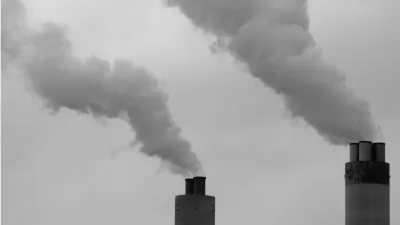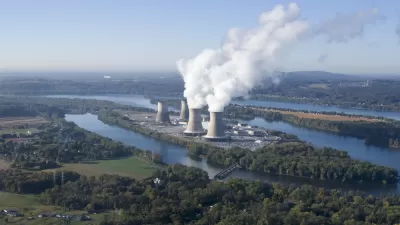The rise is attributed to Asian nations, particularly India and China, where coal-power plants are newer than in the West. It shows a growing disconnect between energy and climate goals, warned the International Energy Agency.

"Fatih Birol, head of the International Energy Agency (IEA), said the growth of coal-fired power in Asia was worrying because the new plants would 'lock in the emissions trajectory of the world, full stop',” report Leslie Hook, David Sheppard and Myles McCormick. The average age of Asian coal plants is 11 years, compared to Western coal plants averaging 42 years. Worse yet, despite being newer, many are less efficient than those used in Europe and the U.S.
“How we are going to deal with this problem is for me the nerve centre of the climate change debate today,” Mr Birol told the Financial Times, adding that the data on energy consumption is moving in “close to the opposite direction” of climate targets.
Energy-related carbon dioxide emissions ticked up 1.4 per cent last year, following several years of staying flat, and are set to rise again in 2018 owing to greater demand for fossil fuels. Asia accounted for two-thirds of the growth in emissions last year.
By contrast, emissions decreased last year in the U.S. by 2.7 percent, largely due to a 4.5 percent decrease in power plant emissions as coal-burning plants shuttered.
Last year China’s coal-fired power generation grew 4 per cent, while India’s rose 13 per cent, according to IEA data. The rate of investment in the construction of new coal-fired power plants, however, also slowed down last year, according to the agency.
Mr Birol said the Asian coal plants were a crucial reason why renewable energy consumption and carbon dioxide emissions were both increasing at the same time. “It’s one of the blind spots of the climate change discussion,” he said.
BP's "Statistical Review of World Energy," released in June, confirms the IEA data.
"The opening of new coal-fired power plants in India and China drove coal consumption higher by 1 percent, highlighting the difficulties developing economies face in meeting demand for electricity while fighting pollution," reported Ron Bousso for Reuters on June 13 on the BP report [pdf].
Page 13 lists coal consumption by country. China's consumption peaked in 2013 and dropped every year until 2017. [Also see "related" posts below.] India, on the other hand, has increased consumption every year since 2007.
[T]he share of [global] coal in power generation today remains around 38 percent, practically unchanged since 1997, while the share of non-fossil fuels slightly dipped as nuclear power capacity shrunk, BP Chief Economist Spencer Dale said.
“This is really worrying,” Dale told reporters in a briefing before the report was released. “How much progress have we made in 20 years? None.”
A final grim note: Feng Hao of China Dialog reports that "CoalSwarm published a report [pdf] on September 26 warning that 259 gigawatts of coal power capacity – equivalent to the entire coal power fleet of the United States – is being built in China despite government policies restricting new builds."
Related in Planetizen:
-
China Cancels 103 Coal Power Plants; Still Has Too Much Coal Capacity, January 20, 2017.
-
China Cutting Carbon, October 1, 2016: China’s coal use and carbon emissions have dropped for the last two years.
-
Peak Coal: China's Carbon Emissions Drop as the Use of Coal Slows, August 10, 2016: China's use of coal peaked in 2014.
FULL STORY: New Asian coal plants knock climate goals off course

Planetizen Federal Action Tracker
A weekly monitor of how Trump’s orders and actions are impacting planners and planning in America.

Map: Where Senate Republicans Want to Sell Your Public Lands
For public land advocates, the Senate Republicans’ proposal to sell millions of acres of public land in the West is “the biggest fight of their careers.”

Restaurant Patios Were a Pandemic Win — Why Were They so Hard to Keep?
Social distancing requirements and changes in travel patterns prompted cities to pilot new uses for street and sidewalk space. Then it got complicated.

Platform Pilsner: Vancouver Transit Agency Releases... a Beer?
TransLink will receive a portion of every sale of the four-pack.

Toronto Weighs Cheaper Transit, Parking Hikes for Major Events
Special event rates would take effect during large festivals, sports games and concerts to ‘discourage driving, manage congestion and free up space for transit.”

Berlin to Consider Car-Free Zone Larger Than Manhattan
The area bound by the 22-mile Ringbahn would still allow 12 uses of a private automobile per year per person, and several other exemptions.
Urban Design for Planners 1: Software Tools
This six-course series explores essential urban design concepts using open source software and equips planners with the tools they need to participate fully in the urban design process.
Planning for Universal Design
Learn the tools for implementing Universal Design in planning regulations.
Heyer Gruel & Associates PA
JM Goldson LLC
Custer County Colorado
City of Camden Redevelopment Agency
City of Astoria
Transportation Research & Education Center (TREC) at Portland State University
Camden Redevelopment Agency
City of Claremont
Municipality of Princeton (NJ)





























